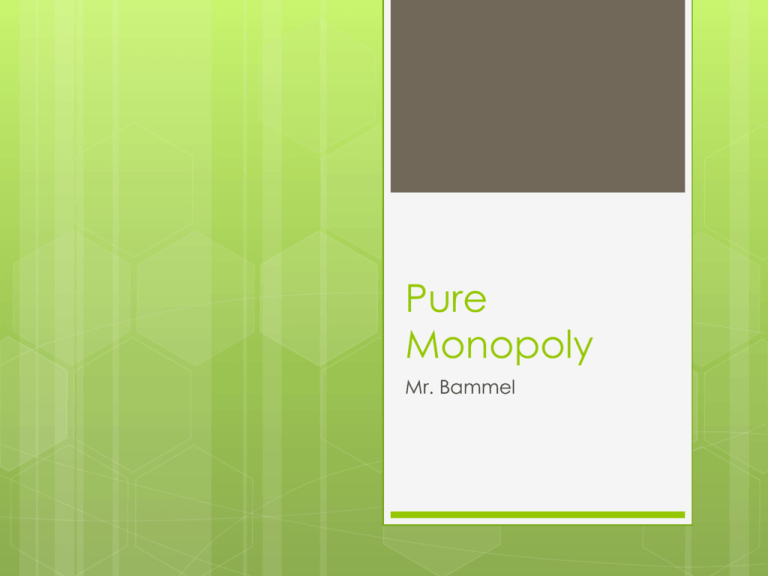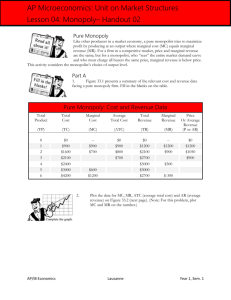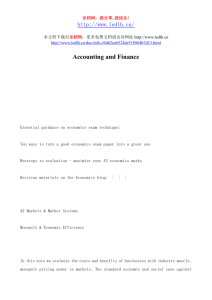Pure Monopoly
advertisement

Pure Monopoly Mr. Bammel Characteristics Single firm is the sole producer The product sold is unique and therefore has no close substitutes; Control over total quantity supplied and thus is a “price maker” Blocked entry due to economic, technological, legal, or some other barrier; Nonprice Competition, using other aspects of the product besides price to drive in the buyers; Examples of Monopolies Majority are government-regulated public utilities – natural gas, electric, water, cable TV, local telephone, etc. Some companies are “near-monopolies” in which one firm controls the bulk of sales; Wham-O (throwing disks) De Beers (rough-cut diamonds) *either way, there is almost always some competition. Barriers to Entry Factors in the industry which block all potential competition; in a Pure Monopoly, there is complete blocked entry; Four prominent barriers: Economies of Scale Legal Barriers to Entry Ownership or Control of Essential Resources Pricing and other Strategic Barriers to Entry Economies of Scale Reminder: As plant size increases, a number of factors will for a time lead to lower average costs of production; When dealing with a monopoly, when the long-run ATC is declining, only a single producer can produce any particular output at minimum total cost; If a small industry tries to enter the market, because of economies of scale of the large industry, the small industry will be undercut because the larger industry can produce at a lower cost and therefore a lower price; the small industry still must charge a higher price to make a profit; Economies of Scale A smaller firm entering the industry does not experience the economies of scale based off the output they produce; they must charge a higher price to make a profit; A larger firm can produce a larger output at a lower cost and therefore make a profit on a lower price; Legal Barriers to Entry Patents: exclusive right of an inventor to use, or to allow another to use, his or her invention; Government seeks to protect the inventor from rivals who mean to take their design and make a profit; Self sustaining patents is when a firm uses their own patent to continue to further strengthen the patent through more research and gain a market position; Ownership or Control of Essential Resources Use private property as an obstacle to potential rivals; Owning a resource essential in the production of a product and not allowing rivals to purchase that resource; Pricing and Other Strategic Barriers to Entry Monopolist creating their own barriers: reducing the price, increasing advertising, etc. Monopolist can be very creative in the barrier process; Monopoly Demand Since the pure monopolist is the industry, its demand curve will also represent the market demand curve; and is Downsloping; B/C of the down-sloping line, the monopolist can only increase the sales/output by decreasing the price; so this means that for every price, except the first, Marginal Revenue will be below the Demand curve; Marginal Revenue below Price The lower price successively charged will now apply to all prior units sold; So you lose money in the price but you gain money in the total output produced with the new price; Each new unit sold increases total revenue by an amount equal to its own price less the sum of the price cuts that apply to all prior units of output; Thus, MR < P at every possible unit except the first; While TR increases, MR is positive; While TR decreases, MR is negative; The Monopolist is the Price Maker Firms with a down-sloping line are price makers; most evident in a pure monopoly; So when a monopolist determines output to produce, they determine the price as well based off the demand line; Setting price at the Elastic Region of Demand TR test when demand is elastic, a decrease in price will increase TR; When demand is inelastic, a decrease in price will decrease TR; *a monopolist will never choose a price-quantity combination where a price reduction will cause a loss in TR; The lower TR and Higher Cost of increase output will lead monopolist to produce in the elastic region; Profit Maximization of Pure Monopoly Maximize Total Profits Same rationale as a profit seeking competitive industry: MR = MC; The price charged will be the price on the demand line matching up with the quantity of MR = MC; Note: can still also use the Total Revenue vs Total Cost approach. Pure Monopolist is without a Supply Curve No unique relationship of price and quantity supplied because a monopolist merely finds the profit maximizing price; The profits are dependent on the quantity demanded/price associated with the output of the point where MR = MC; Misconceptions of Monopoly Not Highest Price: finding highest profits; Total, Not Unit, Profit: max total profits, not max unit profits; the extra units sold at lower price may generate a higher total profit than the high unit profit; Partner up: Without using the Textbook Draw what a loss minimizing position would look like on a graph. If a monopolist was in profit maximizing position, what would be the factors that could bring the monopolist into a loss? Reminder of Pure Competition Efficiency In Monopoly, does society achieve productive and allocative efficiency? Why not? Reminder: Productive efficiency is P = Minimum ATC Allocative efficiency is P = MC Deadweight Loss Because of the efficiency loss of a monopoly, some units that should have been produced are not and the resources are directed elsewhere; The total dollar value of the efficiency loss/deadweight loss is equal to the dollar value of the triangle created by demand, MC and MR; Efficiency Loss of Monopoly Income Transfer Basically a monopolist levies a “private tax” on the consumer, which then ends up in the hands of the owners of the monopoly; Income transferred is equal to the difference between price equilibrium and price charged by a monopolist multiplied by the units sold; Cost Complications There are 4 reasons why cost may be larger or smaller than pure competition: Economies of Scale X-Inefficiency Rent-Seeking Expenditures Technological Advancement Examining Cost Get back with a partner: One of you read about economies of scale and Technological Advancement The Second needs to read about XInefficiency and Rent-Seeking Expenditures Talk with each other and help fill in the notes for each of the 4 cost complications for a Monopoly. Price Discrimination The practice of selling a specific product at more than one price when the price differences are not justified by cost differences; Possible under three conditions: Monopoly power: ability to control price and output; Market Segregation: ability to segregate buyers into distinct classes; No Resale: unable to resale item if part of class buying for lower price; Regulated Monopoly Being subject to rate (price) regulation; Partner 1: read and interpret the graph associated with Price Discrimination on page 479. Be sure to understand how more profits and production is displayed and created through price discrimination; Partner 2: Read and interpret the graph associated with a regulated monopoly on page 480. Be sure to understand the differences between a “socially optimal price” and a “fair-return price.” How will each of these appear graphically?









